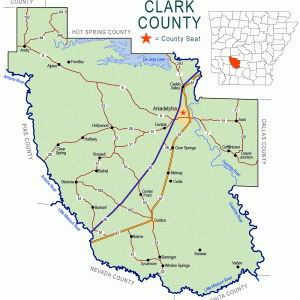calsfoundation@cals.org
Smithton (Clark County)
Smithton is an unincorporated community located about two miles northeast of Gurdon (Clark County). Founded as a lumber town, the community eventually grew to include one of the largest timber mills in the state and became the hub for a short line railroad system.
One of the earliest landowners in the area was John Skinner, who obtained a federal land patent for 640 acres in 1837. Skinner was a land speculator and owned thousands of acres in what are today Clark, Dallas, and Grant counties. Skinner lived in Jefferson County at the time he received the land patent for the acreage in what would become Smithton.
James A. Smith arrived in the Gurdon area in 1873 as a worker on the construction of the Iron Mountain Railroad. Born in Ireland in 1847, Smith moved to the United States in 1867. After recognizing an opportunity to sell supplies to the railroad and its workers, Smith opened a mercantile business in Gurdon in 1879. To diversify his holdings, Smith partnered with B. F. Van Dorn in 1883 to open a lumber mill in what became Smithton. Smith moved his mercantile business to Smithton the following year.
The demand for lumber drove the growth of the company, leading Smith to build a short line to transport logs to the mill. With a vision of an ever-expanding rail system in his head, Smith named the line the Southwest Arkansas and Indian Territory Railway. The tracks first connected Okolona (Clark County) to Smithton, and eventually the line extended to Antoine (Pike County) and Norman (Montgomery County). Smith bought out Van Dorn in 1886, closed his remaining businesses in Gurdon the following year, and organized the Smithton Lumber Company in 1888. Smith held the controlling interest in the company but sold stock to shareholders.
Even though Smith controlled the company, he continued to work alongside his employees at the mill or on the railroad on occasion. While doing so in the winter of 1888–89, he contracted pneumonia, dying on January 11, 1889. Upon his death, his controlling interest in the company became the property of his wife, Mary. She continued to run the company for several years. Mary Smith was a well-respected member of the timber industry, gaining membership as the only female member of the Concatenated Order of Hoo-Hoo, founded in Gurdon. She remained the only female member until her death in 1926, and no other women were part of the organization until after a change in the bylaws in 1993.
A post office opened to serve the growing population in the area, although different dates appear in sources for the actual beginning of operations of the office. It opened in either 1883 or 1884. A number of postmasters and postmistresses operated the facility, including Mary Smith from 1894 until 1905. The post office closed in 1955, and service was assumed by the office in Gurdon.
A school for white children operated in the community, although the exact dates of operation are unknown. Both Rose and May Smith, the daughters of James and Mary Smith, taught at the school at various times. A school for African American children also operated in the area, although details are difficult to determine. The area is served by the Gurdon School District in the twenty-first century.
Smithton was perhaps best known at one time for the immense pile of sawdust located in the community. People traveled from all around to see the massive pile, and a mention of the sawdust appeared in the Ripley’s Believe It or Not! newspaper strip in the 1930s.
The economy of the town centered on the lumber mill and the railroad. The post office was located for decades in the community’s only store, the Smithton Lumber Company Commissary. A fire in 1942 caused extensive damage to the mill, with another fire in 1945 causing $35,000 worth of damage. The second fire destroyed the commissary and post office. Increased competition led to the closure of the mill in the mid-twentieth century. With the major employer in the community no longer active, many of the residents of Smithton moved to nearby towns that continued to support lumber mills.
The twenty-first-century community remains very rural, centered on the still active railroad tracks. Several homes and the Eastern Star Baptist Church are located in the community, as are several industrial businesses. The majority of the land is heavily timbered, much as it was when Smith located his mill at the site. The community can be reached from U.S. Highway 67 via Smithton Road, which continues through Smithton and links the settlement with Gurdon to the southwest.
For additional information:
“$35,000 Fire at Smithton Lumber Mill.” Arkansas Gazette, December 3, 1945, p. 2.
Ragsdale, John G. “Who Are the Hoo-Hoo?” Clark County Historical Journal (2003): 47–48.
Richter, Wendy, et al. Clark County Arkansas: Past and Present. Arkadelphia, AR: Clark County Historical Association, 1992.
“Smithton Lumber Company Fire Damage $20,000.” Arkansas Gazette, December 1, 1942, p. 6.
David Sesser
Southeastern Louisiana University
 Clark County Map
Clark County Map 



Comments
No comments on this entry yet.